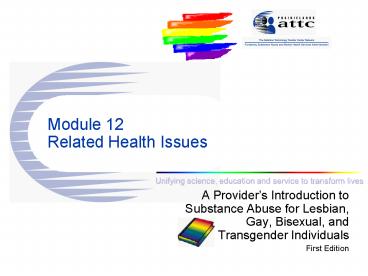Module 12 Related Health Issues - PowerPoint PPT Presentation
1 / 13
Title:
Module 12 Related Health Issues
Description:
Related Health Issues ... Be able to recognize and assess mental health issues ... Recent research on mental health issues for LGBT persons indicates that there is ... – PowerPoint PPT presentation
Number of Views:42
Avg rating:3.0/5.0
Title: Module 12 Related Health Issues
1
Module 12Related Health Issues
- A Providers Introduction to Substance Abuse for
Lesbian, Gay, Bisexual, and Transgender
Individuals - First Edition
2
Related Health Issues
- Learning Objectives
- Understand health issues for LGBT persons
- Be able to list barriers to adequate health care
- Be able to recognize and assess mental health
issues - Understand the effect of interpersonal violence
in the LGBT community
Power Point Slide 12-1, n21
3
True Or False
- LGBT people are the victims of the most violent
hate crimes in America.
- TRUE
- Hate crimes based on sexual orientation are
probably among the most underreported crimes. - Hate crimes against sexual minorities are
generally more violent than other hate crimes.
Power Point Slide 12-2, n22
4
True Or False
- FALSE
- Lesbians may be at increased risk for HPV
infection and, hence, cervical cancer, depending
on their sexual practices. - Lesbians typically see healthcare providers less
frequently than do heterosexual women, and, thus,
may not undergo sufficient screening.
- Lesbians are at lower risk for breast and
cervical cancer than heterosexual women.
Power Point Slide 12-3, n23
5
True Or False
- TRUE
- Hepatitis A and B can be transmitted through
sexual contact. - Hepatitis B and C can be transmitted through
sexual contact and/or sharing needles.
- Gay men are at higher risk
- for hepatitis A and B, and, in some cases,
hepatitis C.
Power Point Slide 12-4, n24
6
True Or False
- There is a relatively low prevalence of HIV
infection among male-to-female transgender
persons.
- FALSE
- In recent San Francisco study HIV prevalence
among MTF persons was 35 and 65 among
African-American MTFs. - Other recent studies of transgender health risks
in urban areas around the country show similar
results.
Power Point Slide 12-5, n25
7
True Or False
- Gay men tend to smoke less than heterosexual
men.
- FALSE
- Recent and representative studies among gay men
have indicated strikingly higher rates of smoking
among gay men than in the general male
population.
Power Point Slide 12-6, n26
8
True Or False
- Gay and bisexual men are at higher risk for HIV
but lower risk for gonorrhea and chlamydia.
- FALSE
- Even when men who have sex with men refrain from
unprotected anal sex, they may engage in other
activities such as unprotected oral sex that
increases risk for both gonorrhea and chlamydia.
Power Point Slide 12-7, n27
9
Barriers to Adequate Health Care
- Many gays and lesbians do not disclose their
sexual orientation to their healthcare providers.
- Many LGBT persons are reluctant to use mainstream
healthcare services. - Gay and Lesbian Medical Association Survey (1994)
results indicate substandard care for LGBT
patients.
Power Point Slide 12-8, n28
10
Mental Health Issues
- Recent research on mental health issues for LGBT
persons indicates that there is a higher rate of
bipolar and depressive disorders in gay men than
among heterosexual men. - Atkinson et al. found higher rates of lifetime
depression in homosexual males compared with
heterosexual men. - Gilman et al. found significantly higher
prevalence rates of depressive disorders in
lesbian women compared with heterosexual females.
- Distinct barriers to mental health service
utilization have been described for sexual
minorities that include - A tendency to pathologize LGBT identity
- Lack of LGBT-sensitive care
- Discrimination and marginalization of LGBT
clients - Unwillingness to address LGBT-related issues in
treatment - Unwillingness to work with partners and lovers of
LGBT - clients.
Power Point Slide 12-9, n29
11
Research on Interpersonal Violence in the LGBT
Community
- Overall the same rate in same-sex relationships
as in heterosexual relationships. - 8 rate of partner violence in a diverse,
nonclinical sample of nearly 2,000 lesbians. - 17 of gay men reported having been in a
physically violent relationship (Gay and Lesbian
Community Action Council 1987). - 40 of 228 gay male perpetrators abused drugs
(Farley 1996). - 25-33 of same sex couples report some sort of
abuse (Page, 2000).
Power Point Slide 12-10, n30
12
Assessment and Intervention
- Ask about interpersonal violence in private
- Ensure confidentiality
- Ask questions in an affirming and culturally
sensitive manner - Empathize with clients feelings
- Look for indicators of interpersonal violence
- Use third-person examples to screen possible
batterers - If a client is identified as either a victim or
batterer, refer him or her to an LGBT support
group, to an LGBT affirmative batterers
intervention program, and for ongoing
consultation with an LGBT domestic violence
treatment expert
Power Point Slide 12-11, n31
13
CASE EXAMPLES
- How would you proceed
- with the assessment?
- What questions would
- you ask and how would
- you ask them ?
- Ron
- DeeDee
Power Point Slide 12-12, n32































